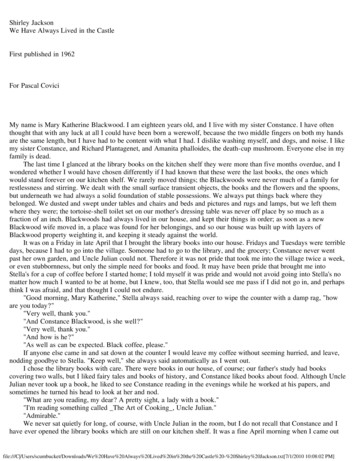
Transcription
The Interior Castle or The MansionsAuthor(s):Teresa of Avila, St.Zimmerman, Benedict (Editor)Publisher:Grand Rapids, MI: Christian Classics Ethereal LibraryDescription:Interior Castle is the work of 16th century Carmelite nun andChristian mystic St. Teresa of Avila. She wrote Interior Castleas a spiritual guide to union with God. Her inspiration for thework came from a vision she received from God. In it, therewas a crystal globe with seven mansions, with God in theinnermost mansion. St. Teresa interpreted this vision as anallegory for the soul's relationship with God; each mansionrepresents one place on a path towards the "spiritual marriage"--i.e. union--with God in the seventh mansion. Onebegins on this path through prayer and meditation. She alsodescribes the resistance that the Devil places in variousrooms, to keep believers from union with God. Throughout,she provides encouragements and advice for spiritual development. Beyond its spiritual merit, Interior Castle also contains much literary merit as a piece of Spanish Renaissanceliterature. A spiritually challenging book, Interior Castle standson par with other great works of this time, such as Dark Nightof the Soul.Tim PerrineCCEL Staff Writeri
ContentsTitle Page1Note3Introduction4Preface17The First Mansions19Chapter I. Description of the Castle20Chapter II. The Human Soul.24The Second Mansions31Chapter I. War.32The Third Mansions38Chapter I. Fear of God39Chapter II. Aridity in Prayer43The Fourth Mansions48Chapter I. Sweetness in Prayer.49Chapter II. Divine Consolations55Chapter III. Prayer of Quiet59The Fifth Mansions68Chapter I. Prayer of Union69Chapter II. Effects of Union75Chapter III. Cause of Union80Chapter IV. Spiritual Espousals85The Sixth Mansions89Chapter I. Preparation for Spiritual Marriage90Chapter II. The Wound of Love96Introductory Note to Chapter III by the Editor100Chapter III. Locutions103ii
Chapter IV. Raptures110Chapter V. The Flight of the Spirit117Chapter VI. Spiritual Jubilation122Chapter VII. The Humanity of Our Lord128Chapter VIII. Intellectual Visions135Chapter IX. Imaginary Visions140Chapter X. Intellectual Visions Continued146Chapter XI. The Dart of Love149The Seventh Mansions154Chapter I. God's Presence Chamber155Chapter II. Spiritual Marriage160Chapter III. Its Effects165Chapter IV. Martha and Mary170Epilogue176Subject Index178Indexes187Index of Scripture References188Index of Pages of the Print Edition190iii
This PDF file is from the Christian Classics Ethereal Library, www.ccel.org. The mission ofthe CCEL is to make classic Christian books available to the world. This book is available in PDF, HTML, ePub, Kindle, and other formats. Seehttp://www.ccel.org/ccel/teresa/castle2.html. A free audio narration is available at http://www.ccel.org/ccel/teresa/castle2/mp3. Discuss this book online at http://www.ccel.org/node/3585.The CCEL makes CDs of classic Christian literature available around the world through theWeb and through CDs. We have distributed thousands of such CDs free in developingcountries. If you are in a developing country and would like to receive a free CD, pleasesend a request by email to cd-request@ccel.org.The Christian Classics Ethereal Library is a self supporting non-profit organization atCalvin College. If you wish to give of your time or money to support the CCEL, please visithttp://www.ccel.org/give.This PDF file is copyrighted by the Christian Classics Ethereal Library. It may be freelycopied for non-commercial purposes as long as it is not modified. All other rights are reserved. Written permission is required for commercial use.iv
Title PageTHE INTERIOR CASTLE1ORTHE MANSIONSBySt. Teresa of AvilaTranslated from the Autograph of St. Teresa of Jesus byThe Benedictines of StanbrookRevised, with Notes and an Introduction, by theVery Rev. Fr. Benedict Zimmerman, O.C.D.PRIORThird Edition with Additional NotesThomas Baker, London[1921]Nihil Obstat:Dom Michael Barrett, O.S.B.Censor DeputatuusImprimatur:EdwardApostolic AdministratorBirmingham,Oscott.February 24, 19211
Title PageDEDICATED TOThe Martyred Daughters of St. Teresa,The Blessed Martyrs of Compiegne, France,by the Descendants of Their Fellow Prisoners.Stanbrook AbbeyDay of the BeatificationMay 27, 19062
NoteNOTEIN this new edition the wording has been revised and condensed, chiefly with a viewto rendering the translation more pregnant. Only one passage (VI. Mansion, ch. v. r 3) hasbeen substantially changed, in conformity with an explanation received from a high authority.It is admittedly a very difficult passage which appears to have been misunderstood by nearlyall translators; but it is gratifying to notice that the new French translation by the Carmelitenuns of Anderlecht agrees with our interpretation. The editor is under an obligation to thattranslation for several interesting facts embodied in the Introduction and in the notes tothe text.B. Z.WINCANTONDecember 25, 191153
IntroductionTHEINTERIOR CASTLE7ORTHE MANSIONSThe Benedictines of Stanbrook desire to express their gratitude to the very Rev. BenedictZimmerman for having kindly revised thetranslation of the ‘Interior Castle’ and alsofor the Introduction, Notes, and Index whichhe has added to the book.89INTRODUCTIONSAINT TERESA began to write the Interior Castle on June 2, 1577, Trinity Sunday, andcompleted it on the eve of St. Andrew, November 29, of the same year. But there was a longinterruption of five months,1 so that the actual time spent in the composition of this workwas reduced to about four weeks—a fortnight for the first, and another fortnight for thesecond half of the book. The rapidity with which it was written is easily explained by thefact that the Saint had conceived its plan some time previously. On January 17, 1577, shehad written to her brother, Don Lorenzo de Cepeda, at Avila: ‘I have asked the bishop—DonAlvaro Mendoza—for my book (the Life) because I shall perhaps complete it by addingthose new favours our Lord has lately granted me. With these one may even compose a newwork of considerable size, provided God grants me the grace of explaining myself; otherwisethe loss will be of small account.’2 She never asked for permission to write anything, butwaited until she received a command from her superiors, which, in this case, came fromFather Jerome Gracian, superior of the Discalced J. Carmelites of the Provinces of Andalusia101Castle, Mansions v. ch. iv. I.2Letters of St. Teresa, Vol. ii.4
Introductionand Castille, and from Don Alonso Velasquez, canon of Toledo, afterwards bishop of Osma.3The Saint was not in good health at the time; she repeatedly complains of noises in the headand other infirmities, but, worst of all, she was weighed down by troubles and anxietiesresulting from the action of the superiors of the Order and of the Papal Nuncio against thenuns and friars of the Reform. Matters became even more serious when, in October, thenuns of the Incarnation of Avila proceeded to the election of a new prioress. Notwithstandingthe prohibition of the provincial, fifty-five electors recorded their votes in favour of the Saintand were immediately declared excommunicated. The whole work of the Reform seemedon the brink of ruin, the Saint, as well as all her friends, was in disgrace, subject to obloquyand ill-treatment.No trace of these trials is to be found in the Interior Castle. Saint Teresa possessed thepower of concentration of thought in a marvellous degree. The early mornings and lateevenings were devoted to the composition of the book, while the rest of the day was takenup by the affairs of the Order. Mother Mary of the Nativity, a member of the communityof Toledo, where the book was begun, declared afterwards,4 that she often saw her writing,generally after Holy Communion, her face resplendent, with such rapidity and so absorbedin her occupation that she seemed undisturbed by, and in fact quite unconscious of, anynoise that was made. Mother Mariana of the Angels5 reports having heard from the samewitness, that entering her cell one day to deliver a message, the holy Mother was just beginning a new sheet of her book. While taking off her spectacles to listen to the message shewas seized by a trance in which she remained for several hours. The nun, terrified at this,did not stir, but kept her eyes steadily on the Saint. When she came to, it was seen that thepaper, previously blank, was covered with writing. Noticing that her visitor had discovered3 The French Carmelite nuns in their new translation, Œuvres complètes de Sainte Thérèse, t. vi, Introduction,p. 5, quoting the Año Teresiano, t. vii ad 7 July, and Father Gracian’s Dilucidario, as well as his additions toRibera, show the exact share of Fr. Gracian and Dr. Velasquez in the preliminaries of this work.4Fuente, Obras de Santa Teresa de Jesus. Edit. 1881, Vol. vi, p. 278.5Ibid. p. 178. A somewhat similar incident is reported by Mother Anne of the Incarnation (Ibid. p. 213), butit appears to be wrongly brought into connection with the composition of the Castle. The nun in question hadbelonged to the convent of St. Joseph at Segovia at an earlier period, but there is no evidence that St. Teresavisited this place in the course of the six months during which she composed this work. The Bollandists, indeed,maintain that it was commenced at Toledo, continued at Segovia and completed at Avila (n. 1541), but theirsole authority for including Segovia is the passage in question, which, however, must refer to some other workof the Saint. The sister, passing St. Teresa’s door, saw her writing, her face being lit up as by a bright light. Shewrote very fast without making any corrections. After an hour, it being about midnight, she ceased and the lightdisappeared. The Saint then knelt down and remained in prayer for three hours, after which she went to sleep.511
Introductionit, Saint Teresa put the paper quietly in the box. Another nun, Mary of St. Francis, left thefollowing declaration: ‘I know that our holy Mother wrote four books, the Life, the Way ofPerfection, the Foundations, and the Mansions, which I have seen her writing. Once, whileshe was composing the last-named work, I entered to deliver a message, and found her soabsorbed that she did not notice me; her face seemed quite illuminated and most beautiful.After having listened to me she said: “Sit down, my child, and let me write what our Lordhas told me ere I forget it,” and she went on writing with great rapidity and without stopping.’6Mary of St. Joseph says she heard from Mary of the Nativity that Father Jerome Graciancommanded the Saint to write the Mansions; she, however, begged to be excused, becauseso many books having been written by holy and learned men, there remained nothing fora woman to write. At length she yielded under obedience. This nun (Mary of the Nativity)was frequently in the Saint’s cell while she was writing and she noticed her resplendent faceand the almost preternatural velocity with which her hand travelled over the paper.7Writing to Mother Mary of St. Joseph, Prioress of Seville, November 8, 1581, St. Teresagives her a message for Father Rodrigo Alvarez, S. J.: ‘Our Father (Jerome Gracian, thenprovincial) tells me that he has handed you a book written by me, which perhaps you donot feel inclined to read yourself. Kindly read to Father Rodrigo Alvarez, at his next visit,the last Mansion, but under the seal of confession, as he asks this in his superior wisdom.This is only for you two. Tell him that the person he knows has arrived at this Mansion andenjoys the peace there described; that she is entirely at rest, and that some grave theologianshave assured her that she is on a safe road. In case you could not read these pages to himdo not send him the book, for it might lead to unpleasantness. Until I have his answer onthis matter I will not write to him. Give him my compliments.’At the end of the original manuscript, before the epilogue (marked with Ihs.) there is anotice in Father Alvarez’ hand-writing to this effect: ‘The Mother Prioress of the conventof Seville has read to me this seventh Mansion, whither a soul may arrive in the present life.Let all the saints praise the infinite goodness of God, Who communicates Himself to Hiscreatures so that they truly seek His glory and the salvation of their neighbour. What I feeland judge of this matter is, that everything that has been read to me is conformable toCatholic truth and in accordance with Holy Scripture and the teaching of the Saints. Whosoever has read the doctrine of the Saints, such as the books of St. Gertrude, St. Catharineof Siena, or St. Bridget of Sweden, and other saints and spiritual writers, will clearly understand that the spirit of Mother Tireza (sic) of Jesus is true, since it leads to the same effects1213146Fuente, p. 223.7Ibid. p. 255.6
Introductionas are to be found in the saints; and because this is in truth my judgment and opinion, Ihave hereunto set my name, this, the 22nd day of February, 1582. P. Rodrigo Alvarez.’8The work was copied, probably under the supervision of the Saint, who introducedmany changes; when completed the original was handed to Father Jerome Gracian and tothe Dominican, Fray Diego de Yanguas, for approval. Both, particularly the former, madenumerous corrections, which Fuente, not without reason, calls impertinent, scratching outwhole sentences and adding others. The book thus revised must have enjoyed a certaincelebrity, though not to the same extent as the Life, to which St. Teresa herself preferred it.Scarcely a week after its completion she wrote to Father Salazar, S.J.: ‘If Señor Carillo[Salazar himself] came, the person in question [the Saint] thinks he would find anotherjewel which in her opinion is superior to the former [the Life]. This one reflects nothingforeign to itself, but is resplendent in its own beauty. It is enriched with more delicate enamelsthan the former, the workmanship, too, is more perfect. For, as the person in question says,the jeweller was less experienced when he fashioned the previous one. Moreover, the goldof the new one is of better quality than that of the former, though the precious stones arenot so well set. It has been done, as might be expected, according to the designs of the JewellerHimself.’9 Later on she wrote to Father Jerome Gracian: The book I have written sinceseems to me superior [to the Life]; at least I had more experience when I wrote it.’10One day, speaking with Mother Mary of Jesus on spiritual matters, she said that ourLord had communicated so much to her since she had reached what she described in theseventh Mansion,—the spiritual Marriage,—that she did not consider it possible to advancefurther in this life, in the way of prayer, nor even to wish to do so.11The book was eagerly read by those who were able to obtain copies. At the archiepiscopalSeminary at Salamanca it was read publicly after dinner; the students, contrary to custom,sacrificing the recreation rather than miss so edifying an instruction. The result was thatseveral entered the religious life, one becoming a Franciscan, two others, who had alreadytaken their degrees, joining the Discalced Carmelites.12 We also know of a lady who becamea Poor Clare through reading the Interior Castle.13 The process of Beatification containsthe following evidence of Don Francisco de Mora, architect to Philip III: ‘The same prioress8Autograph, fol. cx.9December 7, 1577. Letters Vol. II.10Jan. 14, 1580. Letters Vol. IV:11Fuente, Obras. l.c. p. 275.12l.c. p. 217.13Ibid. p. 227.715
Introduction(of aconvent of Dominican nuns) being concerned about my salvation gave me a book inmanuscript, called The Mansions, by Mother Teresa, hoping I should derive some benefitfrom it. I fear this was not the case, but it made me acquainted with Teresa of Jesus, thefoundress of the Discalced Carmelite nuns, of whom I had not yet heard, but for whom Inow felt devotion.’14In August 1586 it was decided to print Saint Teresa’s works, the Augustinian Fray Luisde Leon being selected as editor, as he was unconcerned in the quarrels raging round theReform. Accordingly, the manuscript of the Interior Castle was handed to him. On the firstleaf he wrote the following note:’Many passages of this book written by the holy Mother have been scored through,other words being substituted or notes being added in the margin. Most of these correctionsare badly done, the original text being much better. It will be noticed that the holy Mother’ssentences are superior and agree with the context, which is not the case with the corrections.These improvements and glosses may therefore be dispensed with. Having myself read andconsidered everything with great care, it appears to me that the reader, too, should havebefore him the words of the author who knew best what to say; for this reason I have leftout the additions, and have restored what has been changed, excepting only a few correctionsmade by the writer herself. I beg of the reader that he would in charity reverence the wordsand even the letters traced by so holy a hand, and strive to understand what has been written.He will then see that there was no need for corrections; should he fail to understand her, lethim believe that the writer knew what she said, and that her words cannot be tampered withif they are not to lose their meaning; otherwise what was to the point will seem out of place.This is how books become corrupted, useless, and are finally lost.’15When Luis de Leon undertook the editing of St. Teresa’s writings he received a longletter from Don Diego de Yepes, afterwards Bishop of Tarazona, a former friend and confessor of the Saint, in which he records his personal recollections. I shall only insert herewhat he says about the Interior Castle:’This holy Mother desired to see the beauty of a soul in the state of grace, a thing greatlyto be coveted both for the sake of seeing and of possessing it. While this desire lasted, shewas commanded to write a treatise on prayer, of which she had much personal experience.On the eve of the Blessed Trinity, while considering what subject to choose for this treatise,God, Who disposes everything in due season, fulfilled her wish and furnished a suitablesubject. He showed her a most beautiful globe of crystal, in the shape of a castle, with sevenrooms, the seventh, situated in the centre, being occupied by the King of glory, resplendentwith the most exquisite brilliancy, which shone through and adorned the remaining rooms.16171814Fuente, Obras. p. 190.15Autograph. fol. 1.8
IntroductionThe nearer these lay to the centre, the more did they partake of that wondrous light. It didnot, however, penetrate beyond the crystal, for everything round about was a mass ofdarkness and impurity, full of toads and vipers and other venomous animals.She was still admiring this beauty which, by the grace of God dwells in the soul, when,to! the light suddenly disappeared, and the crystal, wherein the King of glory was stillresiding, became opaque and as dark as coal, emitting an intolerable odour; the venomousanimals, formerly held in check outside, obtained admittance into the castle. The holyMother wished that every one should behold this vision, for she thought that no one havingseen the beauty and splendour of grace, which is forfeited by sin and replaced by such repulsive misery, would ever dare to offend God.’She told me this vision on the same day, for in this as well as in other things she was socommunicative that on the following morning she said to me: “How I forgot myself yesterday!I cannot think how it could have happened. Those high aspirations of mine, and the affectionI have for you must have caused me to go beyond all reasonable limits. God grant I mayhave derived some profit therefrom.” I promised her to say nothing about it during herlifetime, but since her death I should like to make it known to all men. From this vision shelearnt four important matters.’First, she came to understand this axiom, which in this form she had never heard of inher life,16 that God is present in all things by His essence, presence, and power. As she wasdeeply humble and submissive and obedient to the doctrine of the Church and the teachingof the learned ministers of God, she never rested until her revelations had been approvedof by her superiors and by theologians, and were shown to be conformable to Holy Scripture.She went so far as to say that if all the angels of heaven said one thing, and her superiorsanother, though she could not doubt that the former were true angels, yet she would holdwhat was told her by her superiors, because faith comes through these and there remainsno room for deceit, whereas revelations coming from angels might be illusionary.’With such regard for obedience, she asked me one day at Toledo—probably at the timewhen she saw the vision of the Castle—whether it was true that God was in all things by Hispower, presence, and essence, to which I replied in the affirmative, explaining it as best Icould on the authority of St. Paul, particularly where he says “the sufferings of this time arenot worthy to be compared with the glory to come that shall be revealed in us,”17 Layingstress on these words, “shall be revealed in us,” she was so overjoyed that I was quite astonished. Though in a way it seemed to me a kind of curiosity, I could not help thinking therewas some mystery about it, for she said: “This is the very thing.”16See Life, ch. xviii. 20. Mansions v. ch. i. 9. The ignorance of the priest who had told her that God was onlypresent by His grace, made a lasting impression on St. Teresa. She was first undeceived by a Dominican.17Rom. viii. 18.91920
Introduction’Secondly, she was greatly surprised at the malice of sin, since, notwithstanding thepresence of God in these various ways, it prevents the soul from partaking of that powerfullight.’Thirdly, she derived such humility and self-knowledge from this vision, that from thatmoment she never thought of herself in all the good she was doing; for she learnt that allthe beauty of the soul emanates from that resplendent light, and that the powers of the souland of the body are enlivened and strengthened by the Power established in the centre,whence comes all our good, so that we have but a small share in our good works. All thegood she did, she from this moment referred to God as its principal author.’Fourthly, she derived from it the subject of the book she was ordered to write on prayer,comparing the seven rooms of the Castle with as many degrees of prayer, whereby we enterwithin ourselves and draw nearer to God. So that, penetrating to the depths of our soul andgaining perfect self-knowledge, we reach the seventh room where God Himself dwells, withWhom we become united by as perfect a union as is possible in the present life, being madepartakers of His light and love.’I will say no more of this vision and the Mansions, because your Reverence must bynow have seen this admirable book, and must know with what accuracy, with what majesticdoctrine, with what lucid examples she describes the progress of the soul from the gate tothe very centre. It is clearly seen in this treatise how she communicated with our Lord, andhow His Majesty vouchsafed to place her in the centre and to unite her with Himself, as sheputs it, by the bonds of marriage and an inseparable union.’18After the publication of the Interior Castle, in 1588 at Salamanca, it became not onlymore widely known, but also more and more appreciated. Francis Suarez, the great theologianof the Society of Jesus, says in his deposition in the process of Beatification that he had readsome of St. Teresa’s works, particularly the Mansions, which contain an absolutely safedoctrine and give proof of a wonderful spirit of prayer and contemplation.19Thomas Hurtado, professor of theology at Seville, speaks as follows:212218Fuente; pp. 131-133.19l.c. 184.10
IntroductionAs often as I read the books of the holy Mother, I admire the wonderfulmanner in which God instructed her in mystical theology for the sake ofsouls giving themselves truly to familiar intercourse with His divine Majesty.But where I most regret my inability of expressing in fitting terms my sentiments towards this excellent teacher is when I look at, and refresh myself inthat Castle with its seven rooms; for there is seen the effect of infusedknowledge such as St. Denis received from St. Hierotheus20 and both fromSt. Paul, and which has been committed to writing in the famous book ofMystical Theology. Hence comes, as from a fountain-head, notwithstandingthe obscurity (to our manner of thinking) of its language, the doctrine of thegreat masters of the spiritual life such as Hugh of St. Victor, St. Bernard,Ruysbroek, Tauler, Gerson, and many others whom I pass by.’Nevertheless, I will boldly say that no one has given us water morelimpid from that Apostolical and Areopagitical well than the holy MotherTeresa, who, in her books, but chiefly in the Mansions, has cleared up insimple language the most difficult questions of this divine theology, and hasbrought forth light from darkness, as it is written: (He) commanded light toshine out of darkness.’21 Who has ever been able to show as clearly as ourSaint how God takes possession of the soul, how He unites Himself with itssubstance, whence comes to the intellect the light of faith, to the will the ardour of love, and to the senses the jubilation over His works? No one hasever turned theory into practice in a more convincing or more catholicmanner. The most profound secrets of this supernatural wisdom are heretreated with such ease, so amiably, so delightfully, they are illustrated by suchnice and homely examples, that instead of awe-inspiring obscurity, we findlovely flowers and the sweetness of love, through which, as through an avenue,the soul passes onwards. When God made known His exalted doctrine to St.Dionysius and other mystical writers, He made use of their own languageand pen. But St. Teresa in the Mansions is like the light of dawn whose raysare not intercepted by the clouds of this world; like a soft rain from above,whereby the soul grows and profits by its communications with God. Untilthe teaching of this great door became known it seemed as though God wereinaccessible, being surrounded by darkness, through which Moses and someother persons had to pass when approaching Him;22 but they neither ex2023Allusion to the famous Mystical Theology attributed to Dionysius the Areopagite, and long considered thechief authority on this subject.212 Cor. iv. 6.22The example of Moses is scarcely to the point (cf. Exod. xxxiii. 11, and Num. xii. 7, 8).11
Introductionplained the manner nor showed the way whereby they came to the enjoymentof the sweetness of the Spouse. Now, however, this way is clear and patentto all, having been pointed out in the Mansions, in language so straight andso methodical, and no longer such as could not be understood, or requiredfurther explanation. In my opinion this holy writer derived not only thesubstance of her teaching from infused knowledge, but even the words withwhich she explains it.’2324Likewise Don Alvaro de Villegas, canon of Toledo, expressed his opinion that the Wayof Perfection and the Interior Castle contain ‘heavenly doctrine.’ The weight of the subjectmatter, the propriety of the comparisons, the force of the expressions, the consistency ofthe teaching, the sweetness of her well-chosen, vivid words, the clearness of the arguments,all this proves that she was guided by her heavenly Spouse, in Whom are hidden the treasuresof the wisdom of God; and that the Holy Ghost, Who more than once was seen resting onher head like a dove, was dilating these works. Villegas does not believe that any one couldread them, as such books ought to be read, without becoming himself a master of the spiritual life. For they are like heavenly dew, rendering the soul fruitful in the matter of prayer.24It would be a mistake to consider the Interior Castle a complete treatise of mysticaltheology. Like St. Teresa’s other works, it is intensely personal: she describes the road bywhich she has been led, being well aware that others may be led in a different way. In theheavenly Father’s house there are many mansions, not only seven, and many paths lead tothem. What gives the work such high value is, that it is the result of a most searching inquiryinto the various phases whereby a soul is gradually transformed into the likeness of GodHimself. Here St. Teresa is always at her best. She takes nothing for granted, even her ownpersonal experiences are admitted only after having been fully investigated and found to beconsistent one with the other, and conformable to the teaching of the Church and the wordsof Holy Scripture.Mystical theology is generally divided into three parts, respectively called the purgative,the illuminative, and the unitive life. In the first, man is cleansed from sin and habitual imperfection by the use of the sacraments and by voluntary mortification of the passions. Themind is purified by sedulous meditation on the last end and on the Life and Passion ofChrist, which must ever be the great model of the Christian. This first portion of the wayto heaven can be covered by the help of the ordinary means of grace, without any direct and23Fuente, pp. 330-332.24l.c. p. 334. These testimonies could be easily multiplied.1225
Introductionextraordinary intervention of divine power. The second part differs in many ways from thefirst. It comprises the passive purification of the soul and the passive enlightenment of themind. By sending it keen interior and exterior trials and sufferings, God completes thecleansing of the soul in a manner far surpassing any voluntary effort of man. By raising itto the stage of contemplation He gives it fresh light on the mysteries of our Redemption.The mind is then no longer com
The Interior Castle or The Mansions Author(s): Teresa of Avila, St. Zimmerman, Benedict (Editor) Publisher: Grand Rapids, MI: Christian Classics Ethereal Library Description: Inter ior Castle is the w ork of 16th centur y Car melite n un and Chr istian m ystic St. Teresa of A vila. She wrote Inter io










